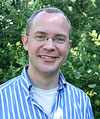Big Bang mathematics provides Hans Ringström with prestigious award
The KTH mathematician Hans Ringström’s research revolves around the mathematics behind the Big Bang. His contribution to studies of cosmological models has been widely reported internationally. Now he is getting attention from the Royal Academy of Sciences, by being awarded one of the most prestigious Swedish research awards, the Göran Gustafsson Prize. In addition to SEK 4.5 million in research grants, he will also receive a personal prize of SEK 100,000.

At a formal gathering yesterday at the Royal Academy of Science’s (KVA), Hans Ringström, 39 years old and an associate Professor of mathematics at KTH, received one of the finest research awards you can get in Sweden: The Göran Gustafsson Prize. A prize which KVA awards each year to five prominent Swedish researchers in mathematics, physics, chemistry, molecular biology and medicine.
Hans Ringström’s research focuses on the mathematics behind the Big Bang and the mathematical problems that arise when studying Einstein’s equations of general relativity. He is being awarded the prize: ”for his fundamental and internationally high-profile contribution to the study of the dynamics of cosmological models”.
In an interesting video presentation on KVA’s website, Hans Ringström provides a brief historical survey of our image of and our theories about the universe. This is done as a background to the type of problems he is dealing with. Hans Ringström mentions of course, Einstein’s general relativity theory and latter-day Big Bang theories. He begins by mentioning the early so-called geocentric view of the world and goes via the Copernican view to the modern version, the cosmological principle.
“It says that for a given moment in time, you cannot distinguish between two points in space. This is called homogeneity. Nor can you distinguish between two directions. This is called isotropy,” says Hans Ringström.
But these assumptions of homogeneity and isotropy have very strong constraints if we are to say something about the global shape of the universe, according to Hans Ringström.
“So it is of interest to know what the constraints are, if we were to assume that the Universe is almost homogeneous and isotropic. And the fact is that in some way we are back in the Middle Age since the observations indicate that the Universe is quite flat in some sense, locally. But what is the global shape? It is by no means certain. "We do not know,” he says.
This year’s Göran Gustafsson Prize in physics goes to Ellen Moons, Docent in Physics of Matter at Karlstad University. Fahmi Himo, Professor of Quantum Chemistry at Stockholm University, is awarded the chemistry prize. The molecular biology prize goes to Jussi Taipale, Professor of Medical Systems Biology at Karolinska Institutet. Torkel Klingberg, Professor of Cognitive Neuroscience at Karolinska Institutet is awarded the prize in medicine.
The Göran Gustafsson Prize has been awarded annually since 1991 by the Göran Gustafsson Foundation for Science and Medical Research. Prize Nominations come from the country’s universities and colleges and are reviewed by the Royal Academy of Sciences, which also hands out the prizes during a formal gathering on 31 March. The Foundation manages funds of around SEK 1 billion.
Håkan Soold

